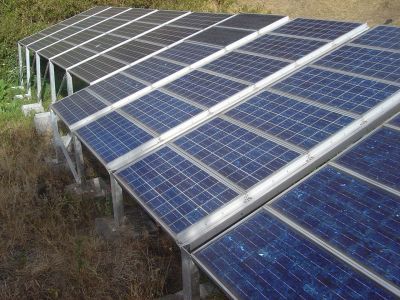Sustainable solar cell modules

Mafate Marla solar panel
By David Monniaux (Own work) [GFDL (http://www.gnu.org/copyleft/fdl.html), CC-BY-SA-3.0 (http://creativecommons.org/licenses/by-sa/3.0/) or CC BY-SA 2.5 (http://creativecommons.org/licenses/by-sa/2.5)], via Wikimedia Commons
Today's solar modules should be nearing the end of their useful life after two decades. EU-funded scientists are focusing on designing solar cells that are more recyclable and also on minimising the environmental impact during their manufacturing.
Photovoltaic (PV) solar power is pollution-free during operation. However, the manufacturing of a PV module consumes many energy resources, and at the end of its lifetime it will eventually become electronic waste. Current manufacturing methods rely on using critical materials such as silver. Recycling is also hardly considered in the module design, making high-value, low-cost recycling methods difficult. As the PV industry is growing fast, the urgency to address these issues increases.
The EU-funded project 'Cradle to cradle sustainable PV modules' (CU-PV) is focusing on maximising energy production, while also minimising the environmental footprint in manufacturing and recycling of PV devices.
To decrease energy demand in manufacturing, CU-PV is designing solar cells that require less silicon — such as thinner wafers — and increase power conversion efficiencies. Back-contact solar cell design will result in using 50 % less silicon and saving about 30 % energy from the PV system production. New metallisation methods suitable for thinner wafers will serve to minimise use of critical materials such as silver and lead. These will be based on physical vapour deposition or ink jetting of seed layers that are plated afterwards with nickel or copper.
Another CU-PV focus is to develop and demonstrate alternatives for current practices used in PV module destruction at the end of their life.
So far, a significant amount of work has been performed with regard to thin substrates and seed layer deposition. Work is ongoing regarding the identification of module materials and fabrication methods suitable for plated back-contact cells and recycling.
Through life-cycle analysis, scientists have identified bottlenecks in the traditional methods for recycling present modules and eventually developed new recycling technology. Tests performed on solar cells with the newly modified materials demonstrated that the recovery process of components is relatively easy and with low environmental impact.
CU-PV objectives are in line with the EU Directive on waste electrical and electronic equipment (WEEE), which in its latest recast has included PV modules within its scope.
published: 2015-05-12

